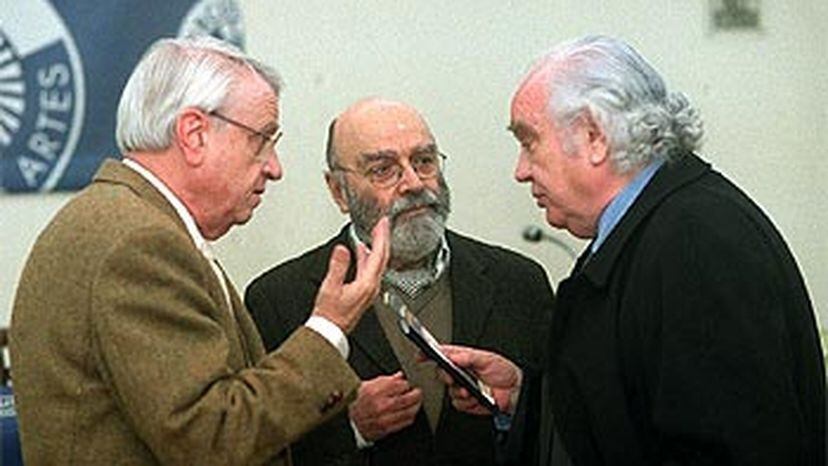Between vineyards and the stone of the walls of his castle in Villafranca del Bierzo (León), Cristóbal Halffter spent much of his life. But not enclosed, but open to the blowing of the sounds that he knew how to imagine to rebuild, after various catastrophes, the music of the twentieth century. He was born in Madrid in 1930 and died this Sunday in Ponferrada at the age of 91, as confirmed by family sources.
More information
He belonged to a line of musicians within a family that suffered the gulf of the civil war. His uncles, Ernesto and Rodolfo, somehow channeled his talent for direction and composition as he has later done with his son Pedro Halffter Caro. He fled the Civil War as a child, with his parents, who took refuge in Germany until the war ended.
Back in Madrid, Halffter, very early, decided to follow in the footsteps of his uncles and in 1947 he entered the Royal Conservatory of Madrid to study with Conrado del Campo. The fate and logic of the calendars want it to end in 1951: just the year in which the generation that has made history in contemporary Spanish music begins with him as one of its great references along with Luis de Pablo, Carmelo Bernaola, Ramón Barce, Joan Guinjoan or Antón García Abril. Of all of them it was the task of rebuilding after the breach of the war and the wasteland of a Spain amputated of talent, a continuity truncated in music. The confrontation and exile had destroyed the careers and lives of those who had to take refuge far away, like his uncle Rodolfo, in Mexico, where he died in 1987, or like Manuel de Falla, in Argentina.
Link to Failure
The Halffters’ link with that exile and with Falla was direct. In fact, Ernesto was in charge of finishing the unfinished work of the Andalusian composer, Atlantis Young Cristóbal drank from that path, who very soon wanted to investigate the vanguard. That concern was banned from Conrado del Campo’s classes. Halffter was interested in the Vienna School —Schoenberg, Alban Berg—, by Bartok, by Stravinski, whom he served as a guide on a visit to Madrid. “With Don Conrado you couldn’t talk about these things, I studied them on my own.”
He therefore decided to take the path of experimentation at a very young age and look to Europe. Specifically to Darmstadt, where he and his generational Spanish colleagues had an active presence. They knew how to seek and connect with the current of their time, from the rupture and risk, to provide new languages the diminished creative capacity of this art in full Francoism.
There they enrolled in the school led by Wolfgang Steinecke since 1946, who just after the end of World War II promoted a continental movement that also had to rebuild from the ruins the new paths of the most disruptive and heterodox world music. Karheinz Stockhausen, Hans Werner Henze, Luigi Nono, Xenakis, Ligeti, Messiaen, Varèse, John Cage went there … In their diatribes, discussions, and often fierce positions, philosophers such as the implacable Adorno participated in musical matters, very in tune with ultra-radical attitudes, like those of Pierre Boulez.

From left to right, Cristóbal Halffter, Luis de Pablo and Antón García Abril, in 2003. In video, the composer reflects on the value of music in contemporary society in a 2009 speech.
All that environment was thoroughly explored by Halffter, who had already composed his first work in 1952, Paschal Antiphon, which had been followed in 1953 by his Concerto for piano and orchestra and two years later his Three pieces for string quartet. Halffter was prolific but measured. In recent years he composed meticulously within the walls of Villafranca, always accompanied by his wife, the pianist María Manuela Caro y Carvajal, Marita (who died in 2017, with whom he had three children: María, Alonso and Pedro), concentrated with his pristine paper and multitude of pens and jars of Chinese ink, with an artisanal dedication and delivered while awaiting enlightenment and genius.
It took him a while to enter the opera. It started late, in the year 2000, when he presented his Quixote at the Teatro Real, with a montage by Herbert Wernicke and a libretto by Andrés Amorós, directed by Pedro, his son. Cervantes’s universe was followed by another commission, Lazarus, by the Kiel Opera, where he also premiered his work based on The chess novelby Stefan Zweig in 2013.
Literature and art were always fundamental inspiration for his work. Apart from Cervantes and Zweig, he sought the poetic encouragement of Juan Ramón Jiménez to Platero and I or Machado, Lorca and Miguel Hernández for their Elegy on the death of three Spanish poets and Goya for his Black paints. He explored the basis of sacred music in several pieces and also established from the avant-garde of twelve-tone and serialism a dialogue with Spanish composers of the Renaissance or Baroque, such as Tomás Luis de Victoria or Juan de la Encina.
His career was developed both in Spain and in Europe, where he played a prominent role in Germany and France, especially. In 1968 the United Nations commissioned him a work (the cantata And it is, Speak out) to commemorate the 20th anniversary of the Declaration of Human Rights. His concern for their degradation wanted to make it clear in The chess novel, his last great work released. There he came to the desperate alarm of Stefan Zweig and before releasing it he confessed to EL PAÍS: “This is a work that warns about the ghosts of Europe, about their collective follies, about the risk of annihilation that he contemplated.”
#Composer #conductor #Cristóbal #Halffter #dies
source https://pledgetimes.com/composer-and-conductor-cristobal-halffter-dies-at-91/
Disqus comments